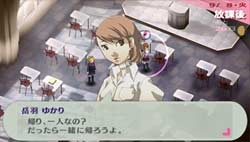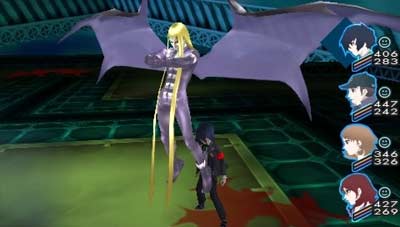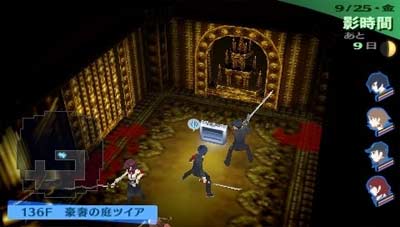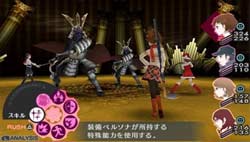Smaller screen…Bigger Game
I’m no fan of game remakes. I figure, unless there is loads of extra content, or you need both hands to count the years between release dates, then remaking a game is unnecessary. However, Persona 3 has become my favorite exception to this rule.

When Persona 3 FES was released just one year after Persona 3, I was ready to grab my pitchfork and protest. However, the game ended up being really good, and the Abyss of Time dungeon as well as the new story elements were enough to win me over in the end. Similarly, when Persona 3 Portable was released a few weeks ago, I was geared up for anger. However, there was so much new content in Persona 3 Portable that I was won over almost instantly. Persona 3 Portable is not just a remake of the original PlayStation 2 title, it is the ultimate Persona 3 experience. If you are a fan of the original, a fan of the MegaTen series, or have even just a passing interest in JRPGs, you owe it to yourself to play this game.
From the game’s first menu screen, the changes to the game are apparent. As soon as the game opens, you are able to choose a character to play as. If you have never played Persona 3, the game recommends you play as the male character, as his story is the “original” and will give you extra story details that are assumed as prior knowledge if you are playing as the female. If you have played Persona 3 though, playing as the female character is definitely a treat. Although the story elements are largely the same, playing as the female allows you to view crucial scenes from a different perspective and gain more insight into the world of Persona 3. The female character also has access to different Personas, and can form social links with different characters (which leads to an alternate Persona development path.)
However, the new female character and new story elements are not the only new things to experience in Persona 3 Portable, as the battle system has been changed as well. As much as I loved the classic RPG feel of the original Persona 3, I was slightly annoyed by having to rely on A.I.-controlled opponents to support me in battle. Even with the game’s intelligent and tactics-based A.I., I was occasionally thrown for a loop when a character would heal me after just taking a few hits. However, Persona 3 Portable’s battle system takes a note from Persona 4 and allows you to control your entire party. This is much more satisfying than the older battle system, and makes the game a bit easier since you don’t have to over-compensate for occasionally incompetent A.I. teammates. In case you were thinking that you don’t like your Persona games too easy, Atlus has you covered, as two new difficulty options have been added to the mix.

Persona 3 Portable also has a few Easter eggs for longtime fans of the franchise, including the first timeline appearance of the main character of Persona 4. Although interactions with this character are fleeting, it is a nice touch that rewards those that have stuck with the series throughout its linear entries, remakes, and re-releases.
All these enhancements and improvements make Persona 3 Portable feel like a brand new game. Despite being the third Persona 3 game to be released in three years, Persona 3 Portable 3 is the most complete entry to date. Even if you have played through the first Persona 3 remake (FES), Persona 3 Portable’s improvements to the battle system and new female protagonist make it worth the price of entry. Playing through just the new story mode will net you at least fifty hours of new gameplay, and if you are the type to go for broke and want to unlock all of the social links and Personas between the two characters, you’ll have a 100+ hour journey ahead of you. For a handheld title, that is phenomenal.

You can expect roughly the same experience on the PSP that you had on the PlayStation 2. The game’s engine still looks great, and although the anime cutscenes have been axed in favor of still images and in-game visuals, the game still holds up. The voiceover for the game is still good, and the voice actors all do a great job here. However, the best part of the remake, as well as the original, is the game’s score. The music here is definitely up there in quality with the best titles, and you won’t soon forget the game’s haunting score, especially during the game’s dramatic final moments. Although the score hasn’t been re-worked extensively for this remake, there are several new tunes that accompany the female character’s new story.

The mechanics in Persona 3 Portable are almost identical to those in Persona 3, with a few small changes. The most notable of these changes is the change from self-guided third-person navigation to point-and-click style navigation. Although some fans may be disappointed with this change, I found that it sped up the gameplay and allowed those playing through the game for the second or third time to get to the plot/battle points easier than before. Plus, walking around never was the highlight of my Persona 3 experience, so I didn’t really miss watching my character walk down the halls of Gekkoukan High School.
Persona 3 Portable is must-play material for JRPG fans. If you have never ventured into the world of Persona 3, now is the perfect time to jump in. Persona 3 Portable represents the best version of the game, and the compelling story, characters, and engrossing social links system will definitely make a fan out of any RPG enthusiast. However, the real treat is playing through Persona 3 Portable as a longtime fan of the series. With the improvements to the battle system and a new character to play, there is plenty left in the world of Persona 3 to explore. In case you were wondering, that ending is just as resonating the second (or third) time around.
RATING OUT OF 5 RATING DESCRIPTION 4.2 Graphics
Visuals look just as good on the PSP as they did on the PlayStation 2. Animations are slick, and character models sport plenty of detail. 4.3 Control
Point and click navigation controls are simple to learn, and menu-based battle system takes almost no time to learn to navigate. 4.0 Music / Sound FX / Voice Acting
Voiceover is infrequent, but sounds good when it is there. The music is beautifully haunting. 4.8 Play Value
Persona 3 was an excellent game to begin with, and if you have never experienced it, Persona 3 Portable is a must-play title. However, if you have played it before, the extra content makes this title worth picking up and playing through again. 4.2 Overall Rating – Great
Not an average. See Rating legend above for a final score breakdown.
Game Features:
